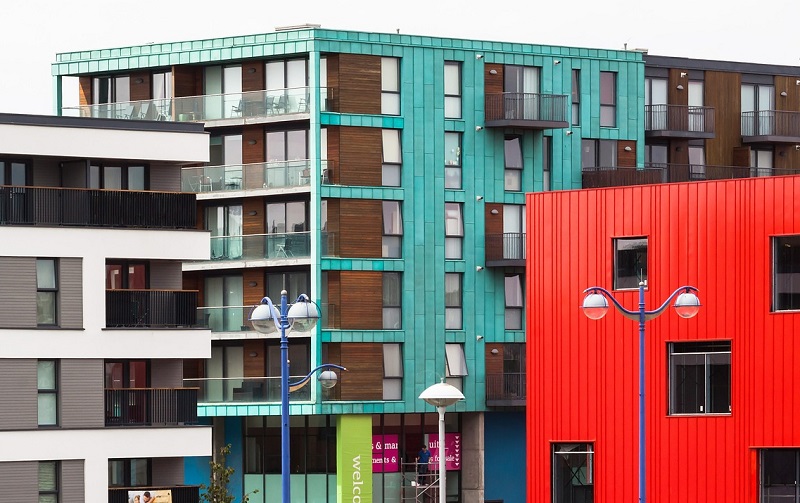Building envelope
According to Approved Document L2B: conservation of fuel and power in existing buildings other than dwellings, the term 'building envelope' refers to:
| ...the walls, floor, roof, windows, doors, roof windows and roof lights. |
Together, these form the physical separation between the interior and exterior, that is, the climatic modifier that creates and contains the internal conditions.
The nature of the building envelope is likely to depend on a wide range of requirements, some of which may be in conflict:
- The type of building.
- Its location and context.
- Its form.
- Regulatory requirements.
- Local climatic conditions.
- The internal conditions required.
- The need for openings, views, security, safety, access, privacy and so on.
- Available materials.
- Structural requirements.
- Building services strategy,
- Sustainability requirements.
- Maintenance and cleaning requirements.
- Rainwater run off.
- Durability, flexibility and expected life.
- The method of construction, deconstructability and recyclability.
- Stylistic requirements.
- Budgetary and time constraints.
NB According to Approved Document L1A:
| The envelope area of a terraced house includes the party wall(s). The envelope area of a flat in a mulit-storey building includes the floors, walls and ceilings which are shared with adjacent flats. |
And, in relation to air permeability:
| The envelope area, or measured part of the building, is the total area of all floors, walls and ceilings bordering the internal volume that is the subject of the pressure test. This includes walls and floors below external ground level. Overall internal dimensions are used to calculate this envelope area and no subtractions are made for the area of the junctions of internal walls, floors and ceilings with exterior walls, floors and ceilings. |
National Calculation Methodology (NCM) modelling guide (for buildings other than dwellings in England) 2013 edition, published by the Department for Communities and Local Government (DCLG), defines ‘envelope area’ as:
|
Area of vertical envelopes (walls) = h * w, where: h = floor to floor height, ie including floor void, ceiling void and floor slab. For top floors, h is the height from floor to the average height of the structural ceiling. w = horizontal dimension of wall. Limits for that horizontal dimension are defined by type of adjacent walls. If the adjacent wall is external, the limit will be the internal side of the adjacent wall. If the adjacent wall is internal, the limit will be half-way through its thickness. NB: Areas of floor, ceilings, and flat roofs are calculated in the same manner as the zone area. Area for an exposed pitched roof (i.e., without an internal horizontal ceiling) will be the inner pitched surface area of the roof. |
Energy Efficiency and Historic Buildings, How to Improve Energy Efficiency, Published by Historic England in 2018, defines the building envelope as:
| The weathertight skin separating the interior of a building from its external environment. It is made up of the roof, walls, windows, doors, floors and foundations; and systems for controlling and disposing of water, including rainwater goods, roof coverings, damp-proof courses and drains). |
[edit] Related articles on Designing Buildings
Featured articles and news
Building Safety Regulator reforms
New roles, new staff and a new fast track service pave the way for a single construction regulator.
Cooling centres and cool spaces
Managing extreme heat in cities by directing the public to places for heat stress relief and water sources.
Winter gardens: A brief history and warm variations
Extending the season with glass in different forms and terms.
Restoring Great Yarmouth's Winter Gardens
Transforming one of the least sustainable constructions imaginable.
Construction Skills Mission Board launch sector drive
Newly formed government and industry collaboration set strategy for recruiting an additional 100,000 construction workers a year.
New Architects Code comes into effect in September 2025
ARB Architects Code of Conduct and Practice available with ongoing consultation regarding guidance.
Welsh Skills Body (Medr) launches ambitious plan
The new skills body brings together funding and regulation of tertiary education and research for the devolved nation.
Paul Gandy FCIOB announced as next CIOB President
Former Tilbury Douglas CEO takes helm.
UK Infrastructure: A 10 Year Strategy. In brief with reactions
With the National Infrastructure and Service Transformation Authority (NISTA).
Ebenezer Howard: inventor of the garden city. Book review.
The Grenfell Tower fire, eight years on
A time to pause and reflect as Dubai tower block fire reported just before anniversary.
Airtightness Topic Guide BSRIA TG 27/2025
Explaining the basics of airtightness, what it is, why it's important, when it's required and how it's carried out.
Construction contract awards hit lowest point of 2025
Plummeting for second consecutive month, intensifying concerns for housing and infrastructure goals.
Understanding Mental Health in the Built Environment 2025
Examining the state of mental health in construction, shedding light on levels of stress, anxiety and depression.
The benefits of engaging with insulation manufacturers
When considering ground floor constructions.
Lighting Industry endorses Blueprint for Electrification
The Lighting Industry Association fully supports the ECA Blueprint as a timely, urgent call to action.






















